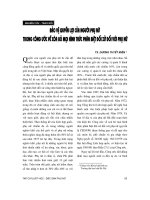Chương 13 Vốn con người, phân biệt đối xử và công đoàn pot
Bạn đang xem bản rút gọn của tài liệu. Xem và tải ngay bản đầy đủ của tài liệu tại đây (96.11 KB, 9 trang )
Chapter 13
Human capital, discrimination and
trade unions
David Begg, Stanley Fischer and Rudiger Dornbusch, Economics,
6th Edition, McGraw-Hill, 2000
Power Point presentation by Peter Smith
13.2
Hourly earnings in the UK 1998
0
2
4
6
8
10
12
14
£.p
Manual Nonmanl
Men Women
■
In both manual and
non-manual
occupations, men
are seen to earn
more than women.
■
Does this mean
there is
discrimination?
13.3
Sources of differential pay
■
Education and training
■
Job experience
■
Race and gender
■
Trade union membership
13.4
Human capital
■
The stock of expertise accumulated
by a worker
■
It is valued for its income-earning
potential in the future
■
A form of investment
13.5
Age-earnings profiles
■
Age-earnings
profiles show how
typical earnings
vary with age and
educational
qualifications
–
education induces a
differential
–
which tends to
increase with age
Age
Income
No formal
qualifications
A-level or
equivalent
University degree
or equivalent
13.6
■
Worker organizations designed to affect
pay and working conditions
■
A closed shop
–
an agreement that all the firm's workers will
be members of a trade union.
■
A trade union may raise wages by
restricting labour supply
Trade unions
13.7
Unions in the labour market
Employment
W
a
g
e
W
0
With no union, the industry
faces a horizontal labour
supply curve at the wage W
0
.
Given industry demand for
labour DD, equilibrium
is at E
0
.
D
D
E
0
N
0
By restricting labour
supply to N
1
, the union
can increase wage to W
1
N
1
W
1
The differential is larger for any
given reduction in industry
employment, the more inelastic
is industry labour demand
13.8
Discrimination?
■
Women and non-whites on average
receive lower incomes than white males
■
women and non-whites are
concentrated in relatively unskilled jobs
with fewer opportunities for promotion
■
This need not reflect blatant sexism or
racism by employers
13.9
Discrimination?
■
It may reflect:
–
educational or other disadvantages before
young workers reach the labour market
–
a low perceived rate of return for firms on
money spent in training such workers
■
Only if we allow for all these effects can
we show discrimination in the labour
market.









